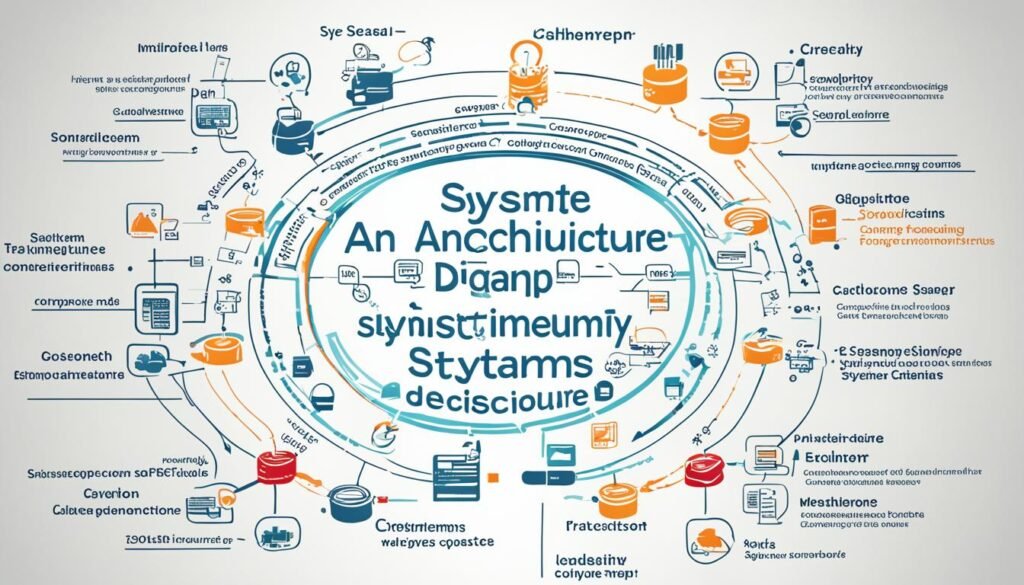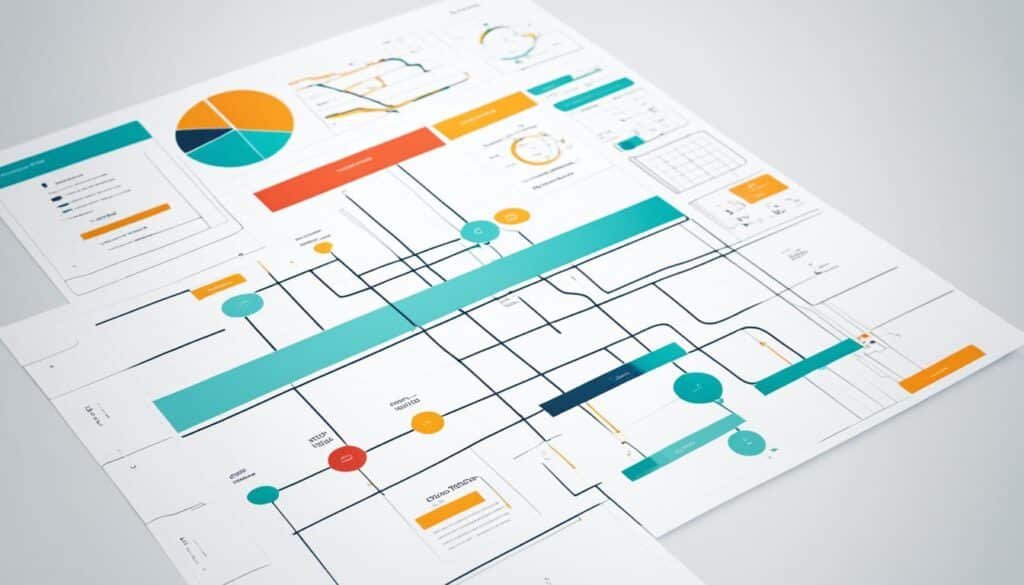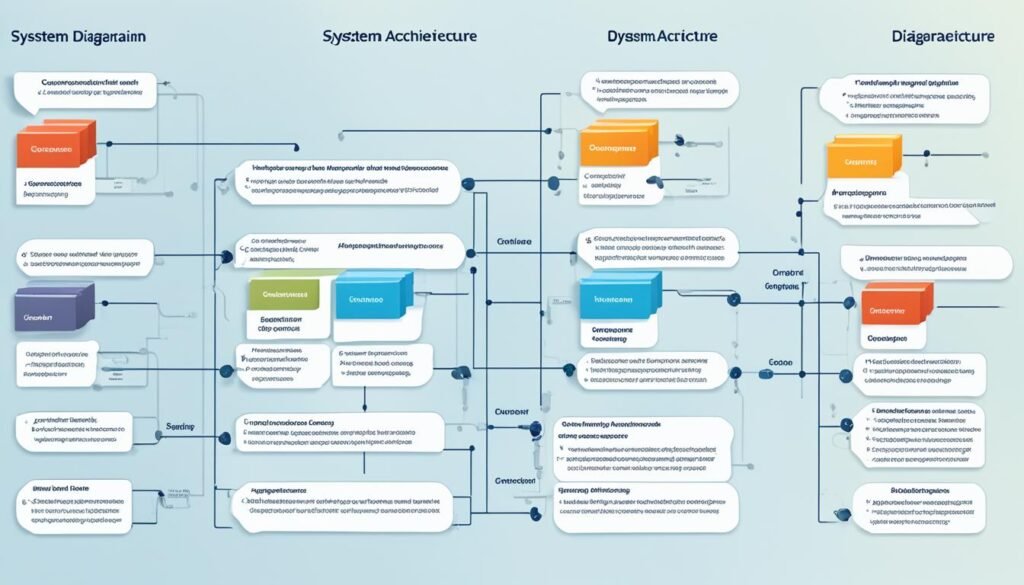Creating system architecture diagrams is a crucial step in software development. These diagrams provide a visual representation of the structure and components of a software system, allowing developers and stakeholders to understand how the system works and make informed decisions.
In this guide, we will explore the different types of architecture diagrams, their purposes, and how to create them using free tools.
Key Takeaways:
- System architecture diagrams are visual representations of software system structures and components.
- They help developers and stakeholders understand the system and make informed decisions.
- There are different types of architecture diagrams for various purposes.
- Free tools like EdrawMax, Lucidchart, and Miro can be used to create architecture diagrams.
- Best practices, such as defining the purpose and identifying components, should be followed when drawing architecture diagrams.
Understanding System Architecture Diagrams
System architecture diagrams play a crucial role in software development by depicting the relationship between software components and the overall structure of a system. These diagrams provide a high-level view of the system’s organization, showcasing how different components interact and serve their specific purposes within the system.
System architecture diagrams serve as visual representations that help stakeholders grasp the overall design and functionality of the system. By visually illustrating the relationships between software components, these diagrams enable a clear understanding of how the system functions as a whole.
The diagram above demonstrates the various components of a software system and their relationships, exemplifying how the different parts collaborate to achieve the system’s purpose.
To create an effective system architecture diagram, it is essential to identify the software components involved, their relationships, and the purpose they serve within the system. By representing this information visually, stakeholders can gain valuable insights into the organization and functionality of the software system.
In the next section, we will explore the benefits of using system architecture diagrams in the software development process, highlighting their role in streamlining development and promoting efficient communication among team members.
The Benefits of Using System Architecture Diagrams

Using system architecture diagrams offers several benefits in the software development process. These diagrams promote efficient communication among development teams by providing a clear visual representation of the system’s design.
By visually illustrating the different components and their relationships, system architecture diagrams facilitate a streamlined software development workflow. Developers can easily analyze and understand the system’s structure, allowing for more efficient planning and execution.
Furthermore, system architecture diagrams enhance communication between stakeholders. These diagrams provide a visual language that transcends technical jargon, enabling clear and effective discussions. With a comprehensive understanding of the software system’s structure, stakeholders can make informed decisions and contribute to the project’s success.
“System architecture diagrams play a crucial role in our software development process. They serve as a common language that bridges the gap between technical teams and stakeholders, ensuring everyone is on the same page.”
Another significant benefit of using system architecture diagrams is the identification of potential bottlenecks. By visualizing the system’s structure, developers can spot areas that may cause performance issues or hinder scalability. This proactive approach allows for early detection and mitigation of potential problems, leading to a more robust and efficient software system.
Overall, the benefits of using system architecture diagrams in software development are clear. From streamlined communication and efficient planning to improved system performance, these visual representations are a valuable asset for developers and stakeholders alike.
Image:
Types of Architecture Diagrams for Software Development
Software development involves the creation of various architecture diagrams to provide an overview of the system’s design and the relationships between its components. These diagrams serve different purposes and help stakeholders understand how the software system functions. The four main types of architecture diagrams commonly used in software development are:
1. Software Architecture Diagram
A software architecture diagram provides an overview of the overall design of a software system. It showcases the different components and their interactions, illustrating how the system is structured and organized. This diagram helps developers and stakeholders visualize the software’s architecture and understand how various components fit together.
2. Application Architecture Diagram
An application architecture diagram focuses on the structure and interactions within a specific application. It showcases the different modules, layers, and components that make up the application. This diagram provides insights into how each component interacts with others and contributes to the overall functionality of the application.
3. Deployment Architecture Diagram
A deployment architecture diagram illustrates how different components of a software system are deployed and interact within a specific environment. It showcases the physical infrastructure, servers, networks, and other resources involved in the deployment process. This diagram helps stakeholders understand how the system is deployed and how the different components communicate with each other.
4. Integration Architecture Diagram
An integration architecture diagram showcases the integration of different systems and technologies within a software system. It provides a visual representation of how different components communicate and exchange data, highlighting the integration points and interfaces. This diagram helps stakeholders understand how various systems and technologies work together to achieve the desired functionality.
By creating and utilizing these architecture diagrams, software development teams can effectively communicate the system’s design, structure, and interactions to stakeholders. These diagrams play a crucial role in ensuring a clear understanding of the software system and facilitating efficient development processes.
Tools for Creating Architecture Diagrams

Creating architecture diagrams is an essential part of software development, as they help visualize the structure and components of a software system. Fortunately, there are various tools available that can simplify the process of creating architecture diagrams. Let’s explore some of these tools:
1. EdrawMax
EdrawMax is a popular diagramming tool that specializes in visualizing software architecture. It provides a user-friendly interface and offers a wide range of templates and symbols specifically designed for creating architecture diagrams. EdrawMax also allows you to customize your diagrams to suit your specific needs, making it a versatile tool for software developers.
2. Lucidchart
Lucidchart is another excellent option for creating architecture diagrams. It is a cloud-based diagramming tool that enables collaborative diagramming, allowing developers and stakeholders to work together in real-time. Lucidchart offers a vast library of shapes and templates, making it easy to create professional and visually appealing architecture diagrams.
3. Miro
Miro is a versatile online whiteboard platform that provides a collaborative environment for creating architecture diagrams. With its intuitive interface and extensive collaboration features, Miro allows development teams to work together seamlessly, regardless of their physical locations. It offers a wide range of pre-built diagramming templates, including architecture diagrams, that can be customized to meet specific requirements.
These tools provide developers and stakeholders with the necessary resources to create and share architecture diagrams effectively. Whether you prefer the flexibility of EdrawMax, the collaborative features of Lucidchart, or the versatility of Miro, these tools can help simplify the process of visualizing software architecture.
Best Practices for Drawing Architecture Diagrams

When creating architecture diagrams, it is important to follow best practices to ensure clear and effective communication. By following these tips, you can create diagrams that accurately represent the system architecture and facilitate understanding among stakeholders.
Define the Purpose
Start by clearly defining the purpose of the architecture diagram. Determine what specific information you want to communicate through the diagram. This helps you focus on the key components and relationships that need to be highlighted.
Identify Components
Identify all the components that will be included in the diagram. These components can include the software modules, hardware systems, databases, APIs, and any other relevant elements. By identifying all the components, you can ensure that the diagram provides a comprehensive overview of the system’s architecture.
Establish Relationships
Once you have identified the components, it’s important to establish the relationships between them in the diagram. Show how the components interact with each other, whether through direct connections, data flows, or dependencies. Clear and accurate representation of these relationships is crucial for understanding the system’s architecture.
Choose the Right Diagram Type
There are various types of architecture diagrams, such as software architecture diagrams, application architecture diagrams, and deployment architecture diagrams. Choose the diagram type that best suits your purpose and the level of detail you want to convey. Each diagram type emphasizes different aspects of the system’s architecture, so make sure to select the one that aligns with your specific needs.
Use Consistent Symbols and Notation
When creating your architecture diagram, use consistent symbols and notation to represent the components, relationships, and other elements. This ensures that the diagram is easy to read and understand. Consistency in symbols and notation also helps maintain clarity and avoids confusion among stakeholders.
Validate for Accuracy and Clarity
Before finalizing your architecture diagram, validate it for accuracy and clarity. Make sure that the diagram accurately represents the system’s architecture and that all the components and relationships are correctly depicted. Additionally, review the diagram for clarity, ensuring that it effectively communicates the intended information to the target audience.
By following these best practices, you can create architecture diagrams that effectively communicate the system’s architecture, helping stakeholders understand and make informed decisions. Remember to define the purpose, identify components, establish relationships, choose the right diagram type, use consistent symbols and notation, and validate the diagram for accuracy and clarity.
Examples of Architecture Diagrams

To better understand architecture diagrams, let’s take a look at some examples. These diagrams provide a visual representation of different aspects of a software system. Here are some common types of architecture diagrams:
System Architecture Diagram
A system architecture diagram depicts the overall structure and organization of a software system. It showcases how different modules and components interact and work together to achieve the system’s objectives.
Website Architecture Diagram
A website architecture diagram illustrates the hierarchy and structure of a website. It includes the navigation menus, content management systems, and the flow of information within the website.
Application Architecture Diagram
An application architecture diagram demonstrates the structure and data flow within a specific application. It shows how different components and services interact to handle user requests and process data.
Deployment Architecture Diagram
A deployment architecture diagram showcases the deployment strategy and environment for a software system. It illustrates how various components, servers, and databases are distributed and interconnected.
These architecture diagrams provide valuable insights into the design and functionality of software systems, helping developers and stakeholders gain a clear understanding of their structure and behavior. They serve as essential communication tools in the software development process, aiding in decision-making and ensuring successful project execution.
Now let’s delve deeper into the importance of taking a collaborative approach in architecture diagramming in the next section.
Importance of Collaborative Approach in Architecture Diagramming

In the process of architecture diagramming, it is crucial to adopt a collaborative approach that involves the entire development team. This approach facilitates effective communication and ensures that every team member comprehends the system’s architecture and its intricacies. By fostering collaboration, development teams can pool their knowledge and insights, resulting in more accurate and comprehensive architecture diagrams.
To facilitate collaborative diagramming, there are several tools available, such as Miro and Lucidchart. These tools provide real-time collaboration features, allowing team members to work together simultaneously. Through these platforms, developers can easily share their ideas, provide input, and make revisions on the architecture diagram, fostering enhanced teamwork and productivity.
Benefits of Collaborative Diagramming:
- Promotes effective communication within the development team.
- Ensures a shared understanding of the system’s architecture.
- Fosters the exchange of ideas, improving the quality of the diagram.
- Facilitates teamwork and enhances productivity.
- Enables real-time collaboration, even for distributed teams.
| Collaborative Diagramming Tools | Key Features |
|---|---|
| Miro |
|
| Lucidchart |
|
A collaborative approach in architecture diagramming ensures that the expertise and insights of the entire development team are leveraged, resulting in more accurate, comprehensive, and well-designed architecture diagrams. By fostering effective communication and collaboration, development teams can create systems that are visually represented in a way that promotes understanding and strategic decision-making.
Significance of Architecture Diagrams in Software Development
Architecture diagrams are vital components of software development, providing clear insights into a system’s structure. These diagrams facilitate a comprehensive understanding of software projects, enabling stakeholders to efficiently plan and execute their development process.
The key significance of architecture diagrams lies in their ability to enhance communication and collaboration amongst development teams. By visually representing the system’s architecture, these diagrams enable efficient planning and strategic execution, ensuring that all team members have a shared understanding of the software system’s design and functionality.
Moreover, architecture diagrams play a crucial role in scalability. As software requirements evolve and change over time, these diagrams assist in the systematic growth and adaptation of the software system. By visualizing the relationships between components, architecture diagrams aid in identifying areas that can be scaled up or modified to meet new demands.
The Role of Architecture Diagrams in Software Development:
- Clear Understanding: Architecture diagrams provide a visual representation of the software system’s structure, enhancing stakeholders’ understanding.
- Efficient Planning: By presenting the system’s components and their relationships, these diagrams facilitate efficient project planning.
- Strategic Execution: With a comprehensive overview of the system’s architecture, development teams can execute their tasks strategically and effectively.
- Scalability: Architecture diagrams help identify areas that can be scaled up or modified to accommodate future requirements.
To illustrate the impact of architecture diagrams, consider an example where a development team is working on a complex software project. By utilizing architecture diagrams, team members gain a clear understanding of the system’s structure and interdependencies. This shared understanding leads to efficient planning and effective execution, resulting in a successful software development journey.
“Architecture diagrams are like blueprints for a software system, guiding teams towards efficient development processes and scalable solutions.”
In conclusion, architecture diagrams are invaluable tools in software development, providing a clear understanding of system structures, enabling efficient planning and strategic execution, and promoting scalability. By leveraging the insights derived from these diagrams, development teams can effectively collaborate and deliver high-quality software systems.
Also Read: Modern Kitchen Design Ideas for Stylish Homes
Conclusion
System architecture diagrams play a vital role in the software development process. These diagrams provide a visual representation of software systems, enabling a better understanding of complex structures, effective communication, and efficient planning.
By following best practices and utilizing collaborative diagramming tools, developers and stakeholders can create effective and impactful architecture diagrams that contribute to the success of software development projects.
Whether it’s designing software architecture, planning software development, or documenting system architecture diagrams, these visual representations contribute to the clarity and efficiency of the entire process. Understanding the structure of the software system aids in making informed decisions, ensuring seamless collaboration, and driving strategic execution.
Software development is a dynamic and ever-evolving field, and system architecture diagrams are crucial for building scalable solutions. These diagrams provide a roadmap for the development team to navigate complex systems, enabling them to adapt to changing requirements and ensure the long-term success and scalability of the software system.
FAQs
Q: What are the key benefits of using software architecture diagrams?
A: Software architecture diagrams help visualize the structure and interactions of a system, making it easier to understand and communicate complex designs to stakeholders.
Q: Could you provide some examples of system architecture diagrams?
A: Examples of system architecture diagrams include client-server architecture, event-driven architecture, and microservices architecture.
Q: How can architectural diagrams visualize system design?
A: Architectural diagrams visually represent the components of a system, their interactions, and the architecture patterns used, providing a clear overview of the system design.
Q: What are some common types of architectural diagrams?
A: Some common types of architectural diagrams are layered architecture diagrams, devops architecture diagrams, and business architecture diagrams.
Q: Why is AWS commonly used in system architecture diagrams?
A: Amazon Web Services (AWS) provides a wide range of cloud computing services that are often integrated into system architectures for scalability, flexibility, and reliability.
Q: How does using software architecture patterns benefit system design?
A: Software architecture patterns provide proven solutions to common design problems, helping to improve the quality, reusability, and maintainability of system architectures.
Q: What is the role of system interactions in architecture diagrams?
A: System interactions depict how different system components communicate with each other, highlighting the flow of data and processes within the architecture.





